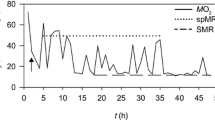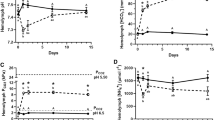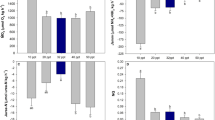Abstract
Homeostatic regulation allows organisms to secure basic physiological processes in a varying environment. To counteract fluctuations in ambient carbonate system speciation due to elevated seawater pCO2 (hypercapnia), many aquatic crustaceans excrete/accumulate acid–base equivalents through their gills; however, not much is known about the role of ammonia in this response. The present study investigated the effects of hypercapnia on acid–base and ammonia regulation in the Dungeness crab, Metacarcinus magister on the whole animal and isolated gill levels. Hemolymph pCO2 and [HCO3 −] increased in M. magister acclimated to elevated pCO2 (330 Pa), while pH remained stable. Additionally, hemolymph [Na+], [Ca2+], and [SO4 2−] were significantly increased. When challenged with varying pH during gill perfusion, the pH of the artificial hemolymph remained relatively unchanged. Overall, ammonia production and excretion, as well as oxygen consumption, were reduced in crabs acclimated to elevated pCO2, demonstrating that either (amino acid) oxidation is reduced in response to this particular stress, or nitrogenous wastes are excreted in an alternative form.









Similar content being viewed by others
References
Appelhans YS, Thomsen J, Pansch C, Melzner F, Wahl M (2012) Sour times: seawater acidification effects on growth, feeding behaviour and acid–base status of Asterias rubens and Carcinus maenas. Mar Ecol Prog Ser 459:85–97
Bellwood O (2002) The occurrence, mechanics and significance of burying behaviour in crabs (Crustacea: Brachyura). J Nat Hist 36(10):1223–1238
Beniash E, Addadi L, Weiner S (1999) Cellular control over spicule formation in sea urchin embryos: a structural approach. J Struct Biol 125:50–62
Boron WF (2004) Regulation of intracellular pH. Adv Physiol Educ 28:160–179
Caldeira K, Wickett ME (2003) Anthropogenic carbon and ocean pH. Nature 425:365
Caldeira K, Wickett ME (2005) Ocean model predictions of chemistry changes from carbon dioxide emissions to the atmosphere and ocean. J Geophys Res 110:C09S04
Cameron JN (1978) Effects of hypercapnia on blood acid–base status, NaCl fluxes, and trans-gill potential in freshwater blue crabs, Callinectes sapidus. J Comp Physiol 123B:137–141
Cameron JN (1985) Molting in the blue crab. Sci Am 252:102–109
Cameron JN, Iwama GK (1987) Compensation of progressive hypercapnia in channel catfish and blue crabs. J Exp Biol 133:183–197
Checkley DM, Dickson AG, Takahashi M, Radich JA, Eisenkolb N, Asch R (2009) Elevated CO2 enhances otolith growth in young fish. Science 324:1683
Chen JC, Cheng SY (1993) Haemolymph osmolality, acid–base balance and shift of ammonotelic to ureotelic excretory pattern of Penaeus japonicus exposed to ambient ammonia. Comp Biochem Physiol 106C:733–737
Compère P, Wanson S, Péqueux A, Gilles R, Goffinet G (1989) Ultrastructural changes in the gill epithelium of the green crab Carcinus maenas in relation to the external salinity. Tissue Cell 21:299–318
Copeland DE, Fitzjarrell AT (1968) The salt absorbing cells in the gills of the blue crab (Callinectes sapidus, Rathbun) with notes on modified mitochondria. Zellforsch 92:1–22
Cruz MJ, Sourial MM, Treberg JR, Fehsenfeld S, Adlimoghaddam A, Weihrauch D (2013) Cutaneous nitrogen excretion in the African clawed frog Xenopus laevis: effects of high environmental ammonia (HEA). Aqua Tox 136–137:1–12
Dickson AG (1990) Standard potential of the reaction AgCl(s) + ½ H2(g) = Ag(s) + HCl(aq), and the standard acidity constant of the ion HSO4 − in synthetic sea water from 273.15 to 318.15 K. J Chem Thermodyn 22:113–127
Dickson AG, Millero FJ (1987) A comparison of the equilibrium-constants for the dissociation of carbonic-acid in seawater media. Deep Sea Res 34:1733–1743
Donelson JM, Munday PL, McCormick MI, Pitcher CR (2011) Rapid transgenerational acclimation of a tropical reef fish to climate change. Nat Clim Chang 2(1):30–32
Dupont S, Dorey N, Stumpp M, Melzner F, Thorndyke M (2013) Long-term and trans-life-cycle effects of exposure to ocean acidification in the green sea urchin Strongylocentrotus droebachiensis. Mar Biol 160:1835–1843
Edward SL, Wall BP, Morrison-Shetlar A, Sligh S, Weakley JC, Claiborne JB (2005) The effect of environmental hypercapnia and salinity on the expression of NHE-like isoforms in the gills of a euryhaline fish (Fundulus heteroclitus). J Exp Zool 303A:464–475
Ehrenfeld J (1974) Aspects of ionic transport mechanisms in crayfish Astacus leptodactylus. J Exp Biol 61:57–70
Engelhardt FR, Dehnel PA (1973) Ionic regulation in the Pacific edible crab, Cancer magister (Dana). Can J Zool 51:735–743
Fabry VJ, Seibel BA, Feely RA, Orr J (2008) Impacts of ocean acidification on marine fauna and ecosystem processes. ICES J Mar Sci 65:414–432
Fehsenfeld S, Weihrauch D (2013) Differential acid–base regulation in various gills of the green crab Carcinus maenas: effects of elevated environmental pCO2. Comp Biochem Physiol 164:54–65
Fehsenfeld S, Kiko R, Appelhans Y, Towle DW, Zimmer M, Melzner F (2011) Effects of elevated seawater pCO2 on gene expression patterns in the gills of the green crab, Carcinus maenas. BMC Genomics 12:488–504
Freire CA, Onken H, McNamara JC (2008) A structure–function analysis of ion transport in crustacean gills and excretory organs. Comp Biochem Physiol 151A:272–304
Gazeau F, Quiblier C, Jansen JM, Gattuso JP, Middelburg JJ, Heip CHR (2007) Impact of elevated CO2 on shellfish calcification. Geophys Res Lett 34:L07603
Goldsmith DJA, Hilton PJ (1992) Relationship between intracellular proton buffering capacity and intracellular pH. Kidney Int 41:43–49
Gutowska MA, Melzner F, Langenbuch M, Bock C, Claireaux G, Pörtner H-O (2009) Acid–base regulatory ability of the cephalopod (Sepia officinalis) in response to environmental hypercapnia. J Comp Physiol B 180(3):323–335
Gutowska MA, Melzner F, Poertner HO, Meier S (2010) Cuttlebone calcification increases during exposure to elevated seawater pCO2 in the cephalopod Sepia officinalis. Mar Biol 157(7):1653–1663
Henry RP, Wheatly MG (1992) Interaction of respiration, ion regulation, and acid–base balance in the everyday life of aquatic crustaceans. Am Zool 32:407–416
Hunter KC, Rudy PP (1975) Osmotic and ionic regulation in the Dungeness crab, Cancer magister Dana. Comp Biochem Physiol 51A:439–447
Ishimatsu A, Iwama GK, Bentley TB, Heisler N (1992) Contribution of the secondary circulatory system to acid–base regulation during hypercapnia in rainbow trout (Oncorhynchus mykiss). J Exp Biol 170:43–56
Jamieson GS, Phillips AC (1988) Occurance of Cancer crab (C. magister and C. oregonensis) megalopae off the west coast of Vancouver Island, British Columbia. Fish Bull 86(3):525–542
Johnson BA, Bonaventura C, Bonaventura J (1984) Allosteric modulation of Callinectes sapidus hemocyanin by binding of L-lactate. Biochemistry 23:872–878
Jones LL (1941) Osmotic regulation in several crabs of the Pacific coast of North America. J Cell Comp Physiol 18:79–91
Kleypas JA, Feeley RA, Fabry VJ, Langdon C, Sabine CL, Robbins LL (2006) Impacts of ocean acidification on coral reefs and other marine calcifiers: a guide for future research. In: Report of a workshop held 18–20 April, 2005, St. Petersburg, Florida sponsored by the NSF, NOAA and the US Geological Survey
Kustu S, Inwood W (2006) Biological gas channels for NH3 and CO2: evidence that Rh (Rhesus) proteins are CO2 channels. Trans clin biol 13:103–110
Langenbuch M, Pörtner HO (2002) Changes in metabolic rate and N excretion in the marine invertebrate Sipunculus nudus under conditions of environmental hypercapnia: identifying effective acid–base variables. J Exp Biol 205:1153–1160
Larsen B, Pörtner H, Jensen F (1997) Extra- and intracellular acid–base balance and ionic regulation in cod (Gadus morhua) during combined and isolated exposures to hypercapnia and copper. Mar Biol 128:337–346
Levi G, Morisi G, Coletti A, Catanzaro R (1974) Free amino acids in fish brain: normal levels and changes upon exposure to high ammonia concentrations in vivo, and upon incubation of brain slices. Comp Biochem Physiol 49A:623–636
Lewis E, Wallace DWR (1998) Program developed for CO2 system calculations. ORNL/CDIAC-105. Carbon Dioxide Information Analysis Center, Oak Ridge National Laboratory, U.S. Department of Energy, Oak Ridge, Tennessee
Luquet CM, Ansaldo M (1997) Acid–base balance and ionic regulation during emersion in the estuarine intertidal crab Chasmagnathus granulata Dana (Decapoda Grapsidae). Comp Biochem Physiol A 117(3):407–410
Martin M, Fehsenfeld S, Sourial MM, Weihrauch D (2011) Effects of high environmental ammonia on branchial ammonia excretion rates and tissue Rh-protein mRNA expression levels in seawater acclimated Dungeness crab Metacarcinus magister. Comp Biochem Physiol 160A:267–277
McDonald DG, McMahon BR, Wood CM (1979) An analysis of acid–base disturbances in the haemolymph following strenuous activity in the Dungeness crab, Cancer magister. J Exp Biol 79:47–58
McGaw IJ (2004) Ventilatory and cardiovascular modulation associated with burying behaviour in two sympatric crab species, Cancer magister and Cancer productus. J Exp Biol Ecol 303:47–63
McGaw IJ (2005) Burying behaviour of two sympatric crab species: Cancer magister and Cancer productus. Sci Mar 69:375–381
McMahon B, Sinclair F, Hassall CD, deFur PL, Wilkes PRH (1978) Ventilation and control of acid–base status during temperature acclimation in the crab, Cancer magister. J Comp Physiol 128B:109–116
Mehrbach C, Culberson C, Hawley J, Pytkowicx R (1973) Measurement of the apparent dissociation constants of carbonic acid in seawater at atmospheric pressure. Limnol Oceanogr 18:897–907
Melzner F, Gutowska MA, Langenbuch M, Dupont S, Lucassen M, Thorndyke MC, Bleich M, Pörtner HO (2009) Physiological basis for high CO2 tolerance in marine ectothermic animals: pre-adaptation through lifestyle and ontogeny? Biogeosciences 6:2313–2331
Miller GM, Watson S-A, Donelson JM, McCormick MI, Munday PL (2012) Parental environment mediates impacts of increased carbon dioxide on a coral reef fish. Nat Clim Chang 2(12):858–861
Nawata CM, Hirose S, Nakada T, Wood CM, Kato A (2010) Rh glycoprotein expression is modulated in pufferfish (Takifugu rubripes) during high environmental ammonia exposure. J Exp Biol 213:3150–3160
Pane EF, Barry JP (2007) Extracellular acid–base regulation during short-term hypercapnia is effective in a shallow-water crab, but ineffective in a deep-sea crab. Mar Ecol Prog Ser 334:1–9
Parker LM, Ross PM, O’Connor WA, Borysko L, Raftos DA, Pörtner H-O (2012) Adult exposure influences offspring response to ocean acidification in oysters. Glob Chang Biol 18(1):82–92
Pauley GB, Armstrong DA, Van Citter R, Thomas GL (1989) Species profiles: life histories and environmental requirements of coastal fishes and invertebrates (Pacific Southwest). Dungeness crab, Seattle
Perry SF, Gilmour KM (2006) Acid–base balance and CO2 excretion in fish: unanswered questions and emerging models. Respir Physiol Neurobiol 154:199–215
Perry SF, Brau MH, Noland M, Dawdy J, Walsh PJ (2010) Do zebrafish Rh proteins act as dual ammonia–CO2 channels? J Exp Zool 313A:618–621
Poole RL (1966) A description of laboratory-reared zoeae of Cancer magister Dana, and megalopae taken under natural conditions (Decapoda Brachyura). Crustaceana 11(1):83–97
Pörtner HO, Reipschläger A, Heisler N (1998) Acid–base regulation, metabolism and energetics in Sipunculus nudus as a function of ambient carbon dioxide level. J Exp Biol 201:43–55
Pörtner HO, Langenbuch M, Reipschläger A (2004) Biological impact of elevated ocean CO2 concentrations: lessons from animal physiology and earth history. J Oceanogr 60:705–718
Reusch TBH (2013) Climate change in the oceans: evolutionary versus phenotypically plastic responses of marine animals and plants. Evol Appl 7:104–122
Ries JB, Cohen AL, McCorkle DC (2009) Marine calcifiers exhibit mixed responses to CO2-induced ocean acidification. Geology 37:1131–1134
Riestenpatt S, Onken H, Siebers D (1996) Active absorption of Na+ and Cl− across the gill epithelium of the shore crab Carcinus maenas: voltage-clamp and ion-flux studies. J Exp Biol 199:1545–1554
Riggs AF (1988) The Bohr effect. Annu Rev Physiol 50:181–204
Rodolfo-Metalpa R, Houlbrèque F, Tambutté É, Boisson F, Baggini C, Patti FP, Jeffree R, Fine M, Foggo A, Gattuso J-P, Hall-Spencer JM (2011) Coral and mollusc resistance to ocean acidification adversely affected by warming. Nat Clim Chang 1(6):308–312
Santos LCF, Belli NM, Augusto A, Masui DC, Leone FA, McNamara JC, Furriel RPM (2007) Gill (Na+, K+)-ATPase in diadromous, freshwater palaemonid shrimps: species-specific kinetic characteristics and α-subunit expression. Comp Biochem Physiol 148A:178–188
Siebers D, Lucu C, Böttcher K, Jürss K (1994) Regulation of pH in the isolated perfused gills of the shore crab, Carcinus maenas. J Comp Physiol 164B:16–22
Somero GN (1986) Protons, osmolytes, and fitness of internal milieu for protein function. Am J Physiol Regul Integr Comp Physiol 251R:197–213
Spaargaren DH (1982) The ammonium excretion of the shore crab, Carcinus maenas, in relation to environmental osmotic conditions. Neth J Sea Res 15:273–283
Spicer JI, Widdicombe S (2012) Acute extracellular acid–base disturbance in the burrowing sea urchin Brissopsis lyrifera during exposure to a simulated CO2 release. Sci Total Environ 427–428:203–207
Stone RP, O’Clair CE (2001) Seasonal movements and distribution of Dungeness crabs Cancer magister in a glacial southeastern Alaska estuary. Mar Ecol Prog Ser 214:167–176
Stumpp M, Trübenbach K, Brennecke D, Hu MY, Melzner F (2012) Resource allocation and extracellular acid–base status in the sea urchin Strongylocentrotus droebachiensis in response to CO2 induced seawater acidification. Aquat Toxicol 110–111:194–207
Sunday JM, Calosi P, Dupont S, Munday PL, Stillman JH, Reusch TBH (2013) Evolution in an acidifying ocean. TREE, xx:1–9
Taylor AC, Morris S, Bridges CR (1985) Oxygen and carbon dioxide transporting properties of the blood of three sublittoral species of burrowing crab. J Comp Physiol 155B:733–742
Terwilliger NB (1998) Functional adaptations of oxygen-transport proteins. J Exp Biol 201:1085–1098
Truchot JP (1976) Carbon dioxide combining properties of the blood of the shore crab Carcinus maenas (L.): carbon dioxide solubility coefficient and carbonic acid dissociation constants. J Exp Biol 64:45–57
Truchot JP (1979) Mechanisms of the compensation of blood respiratory acid–base disturbances in the shore crab, Carcinus maenas (L.). J Exp Zool 210:407–416
Webb JT, Brown GW Jr (1976) Some properties and occurrence of glutamine synthetase in fish. Comp Biochem Physiol 54B:171–175
Weihrauch D, Becker W, Postel U, Riestenpatt S, Siebers D (1998) Active excretion of ammonia across the gills of the shore crab Carcinus maenas and its relation to osmoregulatory ion uptake. J Comp Physiol 168B:364–376
Weihrauch D, Becker W, Postel U, Luck-Kopp S, Siebers D (1999) Potential of active excretion of ammonia in three different haline species of crabs. J Comp Physiol 169:25–37
Weihrauch D, Morris S, Towle DW (2004) Ammonia excretion in aquatic and terrestrial crabs. J Exp Biol 207:4491–4504
Weihrauch D, Wilkie MP, Walsh PJ (2009) Ammonia and urea transporters in gills of fish and aquatic crustaceans. J Exp Biol 212:1716–1730
Weihrauch D, Chan AC, Meyer H, Döring C, Sourial M, O’Donnell MJ (2012) Ammonia excretion in the freshwater planarian Schmidtea mediterranea. J Exp Biol 215:3242–3253
Wheatly MG (1985) The role of the antennal gland in ion and acid–base regulation during hyposaline exposure of the Dungeness crab Cancer magister (Dana). J Comp Physiol 155B:445–454
Wheatly MG, Henry RP (1992) Extracellular and intracellular acid–base regulation in crustaceans. J Exp Biol 263:127–142
Whiteley NM (1999) Acid–base regulation in aquatic crustaceans: role of bicarbonate ions. In: Eggington S, Taylor EW, Raven JA (eds) Regulation of acid–base status in animals and plants. Cambridge University Press, Cambridge, pp 233–255
Whiteley NM (2011) Physiological and ecological responses of crustaceans to ocean acidification. Mar Ecol Prog Ser 430:257–271
Widdicombe S, Spicer JI, Kitidis V (2011) Effects of ocean acidification on sediment fauna. In: Gattuso JP, Hansson L (eds) Ocean acidification. Oxford University Press, New York, pp 176–191
Widdicombe S, Beesley A, Berge JA, Dashfield SL, McNeill CL, Needham HR, Øxnevad S (2013) Impact of elevated levels of CO2 on animal mediated ecosystem function: the modification of sediment nutrient fluxes by burrowing urchins. Mar Pollut Bull 73:416–427
Wright PA, Wood CM (2009) A new paradigm for ammonia excretion in aquatic animals: role of Rhesus (Rh) glycoproteins. J Exp Biol 212:2303–2312
Acknowledgments
The authors would like to thank the animal holding facility of the University of Manitoba for taking care of the crabs and W.G. Anderson for providing the ion chromatography. This work was funded by NSERC Discovery Grants (D.W., J.R.T.) and the University of Manitoba Graduate Fellowship (S.F.). J.R.T. is the Canada Research Chair in Environmental Dynamics and Metabolism (NSERC tier II).
Author information
Authors and Affiliations
Corresponding author
Additional information
Communicated by H.-O. Pörtner.
Stephanie Hans and Sandra Fehsenfeld have contributed equally to this work.
Rights and permissions
About this article
Cite this article
Hans, S., Fehsenfeld, S., Treberg, J.R. et al. Acid–base regulation in the Dungeness crab (Metacarcinus magister). Mar Biol 161, 1179–1193 (2014). https://doi.org/10.1007/s00227-014-2409-7
Received:
Accepted:
Published:
Issue Date:
DOI: https://doi.org/10.1007/s00227-014-2409-7




